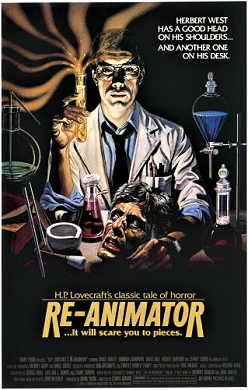Art
This picture displays Frankenstein as barley conscious. It does not portray his full knowledge and his sharp senses. The artist uses the yellow color and shading to give him a rotten dead look, that emphasizes the fact he was made from dead bodies. It shows scars on his forehead to help display the fact that he was sewn together and all the pieces didn't quite come together perfectly. There are also bolts in his neck that connect to his heart. These are present to transfer the lightning into the dead heart to get it beating again.
Literature
 The Re-animator by H.P. Lovecraft is very similar to Frankenstein because the men in it reanimate dead bodies. They have numerous encounters where they bring a dead person back to life but the person is screaming and violent. One incident is when they reanimate a man that goes by the name Halsey. He ends up being very violent and he goes on a cannibal killing spree. He eats 16 people. Other experiments go bad also, causing them to go on killing sprees also. This is all because they wanted to create things that they probably shouldn't have been. It is the opposite of the creature in Frankenstein in that he is misunderstood, conscious, and he's naturally not violent. These creatures like Halsey are unconscious killers.
The Re-animator by H.P. Lovecraft is very similar to Frankenstein because the men in it reanimate dead bodies. They have numerous encounters where they bring a dead person back to life but the person is screaming and violent. One incident is when they reanimate a man that goes by the name Halsey. He ends up being very violent and he goes on a cannibal killing spree. He eats 16 people. Other experiments go bad also, causing them to go on killing sprees also. This is all because they wanted to create things that they probably shouldn't have been. It is the opposite of the creature in Frankenstein in that he is misunderstood, conscious, and he's naturally not violent. These creatures like Halsey are unconscious killers.Music
In the song Rabbits are Roadkill on Route 37 by AFI we experience the feelings of someone who as been abandon by someone they love, leaving them with bitter feelings of self anger and worthlessness.
Desperation, devastation
This song helps us better identify with the monster in the book Frankenstein by Mary Shelley. Victor Frankenstein abandons his creation which left the creature with feelings of isolation, self damnation, and worthlessness and truly turned him into the monster that we see in the book. Now nobody is saying his feelings are enough to justify the murders and horrid acts. However, trying to understand the way the creature feels after being abandon by Victor makes it a bit harder to hate him
Similarities
Some people might be confused how all three of these relate because they don't seem to have much in common. It makes more sense to compare two at a time. For example, the yellow tones of the artwork give it a vintage feel. This pairs nicely with the book The Re-animator from the 80's. When inspecting the tone and word choice of Rabbits are Roadkill on Route 37 by AFI you can sense the sadness and devastation behind the song. This directly correlates to the art depicting the creature in Frankenstein. His face holds these emotions that are expressed in the music. As you can tell there are many similarities between these mediums and these are just a few.

.jpg)



